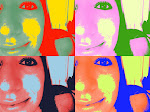In class the other week, my Entrepreneurial Journalism professor Adam Penenberg was discussing the notion of "privacy" today, and how, essentially, having an expectation of privacy is almost absurd nowadays. One example he gave is that New Yorkers are caught on camera 30 to 40 times per day. There are hundreds of cameras within a 1-mile radius of any one place in New York City — traffic/red-light cameras, banks surveillance, police surveillance, ATM camera, convenience store/corner market cameras. They're everywhere, he said.
Surprisingly, this notion hadn't crossed my mind since I moved to New York. I was very aware of cameras in other places I've lived because the communities are so small, cameras seem to stand out more. But in N.Y.C.? In my neighborhood? Hmm.
I decided to start digging to see what I could find about my neighborhood. After doing some research, I found that several different groups had compiled reports, data and maps of all the surveillance cameras around New York City. The New York Civil Liberties Union completed a survey (see the PDF here) that I found to be the most comprehensive.
It reported that, in my area — SoHo and Greenwich Village — in 1998, there were 142 reported cameras. But just a few years later, in 2005, there were a reported 2227 cameras. That's almost 16X the amount in just seven years. And I'd venture to say there are even more today, five years later. (I couldn't find any updated numbers, but if you do, please share!)
And, surprisingly, the other day, I was looking out my window that overlooks Prince Street, as I have hundreds of other times, but this time I noticed a surveillance camera in plain sight. It's visible from ground level, mounted to the side of a brick building on the second floor. The building is actually a friary — yes, as in friars live there (I'm always asked that question when I mention the word 'friary').
I also saw the New York Daily News wrote an article about this issue last year, and I liked how it divided it into the good, the bad and the funny.
It's bad, they said, when someone learns they're being filmed in their own apartments by an NYPD traffic camera, for instance. It's funny when a celebrity is caught in an incriminating act. And it's good when a camera phone captures a lewd act, for example, which is what happened to Thao Nguyen when she saw a man masturbating while staring at her in the subway last year. Nguyen's camera phone caught the act, and her photo made the front page of the Daily News — and it got the man, 43-year-old Daniel Hoyt, arrested.
Nguyen is a prime example of how this kind of technology can help. And her Web site, hollabacknyc.com, collects similar photos, videos and written accounts to "empowers New Yorkers to Holla Back at street harassers." But my favorite part of their objective? "You have the right to feel safe, confident, and sexy, without being the object of some turd's fantasy." Agreed.
The question my professor posed to us at the end of this discussion is the same questions I'm left wondering: What is privacy? Do we have privacy on the phone or Internet anymore? I think not. Did we ever really? The Supreme Court argues the only time you can expect to have privacy is in your home. And sadly, I think that's true. But, as the Daily News reported, even in our own homes we might not have as much privacy as we think (and certainly not if we're using the Internet).
I think this issue poses a lot of questions as it relates to journalism — and citizen journalism, specifically — but that I think I'll tackle another time.
Subscribe to:
Post Comments (Atom)


No comments:
Post a Comment